Heating system installation is an expensive job. In addition to consumables, you need to pay a lump sum to the installation technicians. Many are looking for how to make heating of a private house with their own hands, diagrams for connecting devices and other points of this difficult process. Let's take a closer look at this issue and decide how feasible it is.
Types of heating systems depending on fuel
All types of heating can be divided according to their power sources. Currently, in addition to traditional fuels, alternative sources are used. These are solar energy, hydrogen heating, wind turbines and much more. Inventors and sellers are convinced that the cost of installing expensive equipment will pay off quickly. Let's see.
Heating of a private mansion
Solar power plants and wind turbines for a private house
If you are determined to install a solar power plant, then it will not be superfluous to understand what it is, how to operate this system, and how much it will cost.
In every major city there are companies selling and installing solar electrical equipment. You will be offered a power plant at a cost of 15 thousand rubles, and with it an installation manual, after reading which any master will breathe freely - simple and cheap. Don't be happy in advance! For 15 thousand, you can turn on a couple of LED lamps and a TV, there is no question of heating or even a microwave oven. By the way, this amount does not include solar collectors and many auxiliary parts.
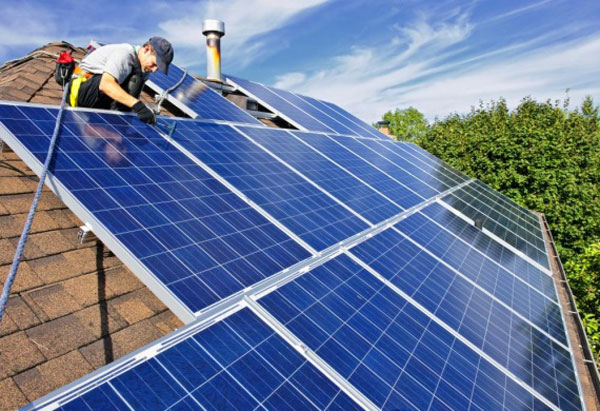
Installation of solar panels
How much do solar panels cost? The cost of the simplest, monocrystalline ones - from 3000 rubles apiece. We made a calculation, and it turned out that the installation of equipment on a private house of 150 square meters, in which it will be possible to connect an electric boiler or a convector heating circuit, will pay off in 7-10 years. And it will cost from 500 thousand to one and a half million rubles! The manufacturer's warranty for the panels is 50 years, but for the equipment it is only 2-3 years. In addition, solar energy, even in hot regions, is not 100% generated all year round: for six months you will receive at most half of the electricity possible. This is due to the seasonal sun and there is nothing you can do about it. Before such equipment pays off, you spend on heating with conventional energy sources. And when it pays off, these sources will still have to be used, because we need heating just in the very little sunny season. We must pay tribute that the installation of solar equipment is really not difficult.

Detailed wiring diagram for solar equipment
Maintenance of solar panels is troublesome. You will have to wipe the collectors after each rain or close them with special curtains.
With wind turbines, the picture is even more depressing. Wind turbines will not be useful everywhere.
The situation is much the same with other alternative sources of heat and light. Therefore, after a little analysis, let's move on to reliable and cheaper fuels.
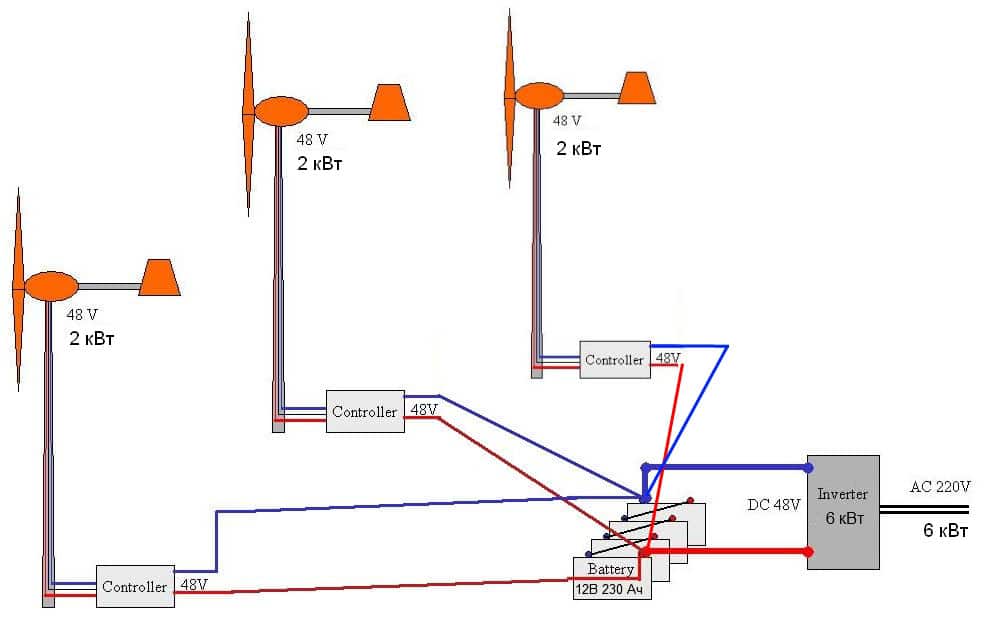
Scheme for wind turbines
Gas heating sources are subdivided into:
- Main pipeline.
- A separate tank for liquefied gas is a gas holder.
- Gas cylinder.
If you need to keep the summer cottage warm on rare Sundays, but cool days, then you can use a gas cylinder. For a large house, this is too expensive and inconvenient.
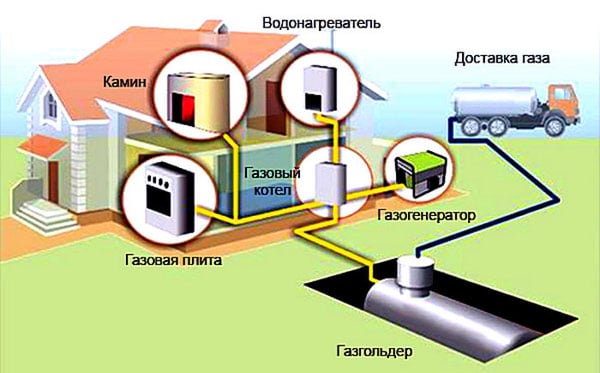
Installing a gas tank in a private house
- Pros and cons of installing a gas tank for a private house
If there is no mains, and you really want to have gas heating, then you can apply this option. The cost of delivery of liquefied gas is different for all regions: on average, from 18 to 22 rubles per liter. For maintenance of a house of 150 sq. you will need an average of 28 liters. for 1 sq.m. area per year, which is approximately 4200 liters. When multiplied by an average cost of 20 rubles per liter, an amount of 84,000 rubles comes out. Is it a lot or not enough, if you add the cost of storage capacity and the entire heating system in the house? It is difficult to say, because winters in each region have different temperature indicators. It can definitely be argued that it is cheaper than many other heat sources. In addition, it is a clean source of fuel and gas boilers can be safely installed within the home.

Gas boiler in the house
Is it possible to save on the installation of gas heating with your own hands? You can do piping and that's it. Connection and permission is done by the corresponding services. This is especially true for the main pipeline. After all, the tie-in into the highway must have a permit. Self-connection is not only prohibited, but also very dangerous. Despite all the difficulties, heating with natural gas is the cheapest today, and you can definitely do half of the work yourself.
Electric heating of a private house
Electric heating can be:
- Infrared.
- Convection.
- Heating system "Warm floor".
- Combined.
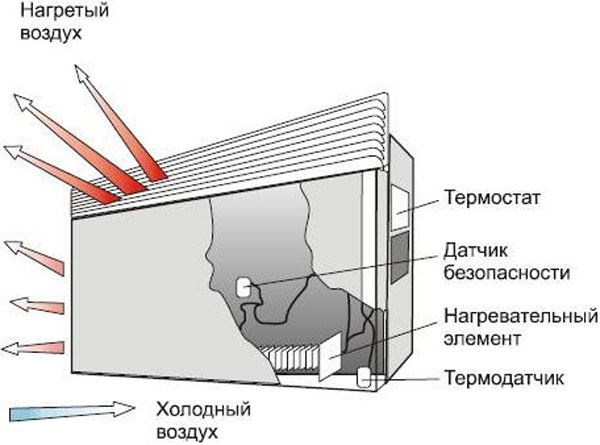
Convector device
Many future owners follow the path of least resistance and install electric heating in their homes. It is much easier to install and connect a warm convection or infrared heating circuit if you know at least the basics of electrical engineering. Moreover, in the instructions for each heating device, a detailed connection guide is indicated. But heating a private house of 150 square meters with heating devices connected to a common meter is an expensive pleasure. It is enough to calculate the energy consumption of each device per day and multiply by the cost of electricity in your region.
In addition, you find yourself dependent on the central power supply. An unpleasant story when the lights go out and in a thirty-degree frost you are left completely without heat. Air cannons, infrared floors and ceilings, convection appliances consume a huge amount of electricity. They can be used as a backup source of electrical heating, but not as the main one.
However, a few words must be said about infrared heating, which has been gaining popularity in recent years. This is the cheapest type of electric heating for a private house. Infrared heating is not based on heating air, but on heating objects. For example, an infrared ceiling coating heats the floor, thus providing excellent heat circulation in the room.
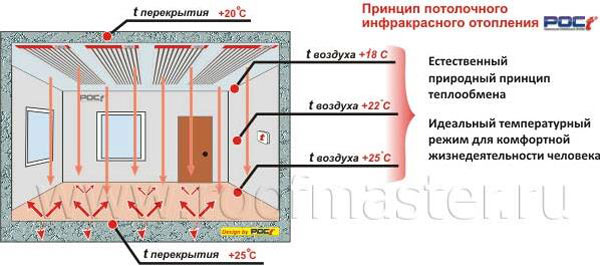
Infrared ceiling heating principle
There are quite a few advantages in such heating:
- Film infrared heating can be installed anywhere: on walls, floors and ceilings. Partial and full coverage possible. Already 50% of the covered floor area will give the required room temperature.
- The infrared coating has a shutdown sensor when the temperature has reached the desired level.
- This type of heating is very economical 50W / 1 sq.m.
- If some part of the coating is damaged, the rest of the surface continues to function.
- Infrared radiation does not dry the air and is not harmful to health.
- Installation of such heating elements is available to anyone.
Video instruction for the installation of infrared heating PEO
Heating with liquid fuel - pros and cons
Those who do not want to constantly throw coal or firewood into the furnace and spend money on electricity, opt for liquid diesel fuel. To organize heating a private house with liquid fuel, a liquid fuel boiler is required.
Heating with diesel fuel has its pros and cons. The advantages are uninterrupted and automated operation and high efficiency. But there are a lot of disadvantages:
- The boiler and the equipment for it are quite expensive.
- Diesel fuel is one of the most expensive types after electricity.
- Safe work requires the construction of a separate room equipped with ventilation and a chimney: the smell from burning diesel fuel is very unpleasant.
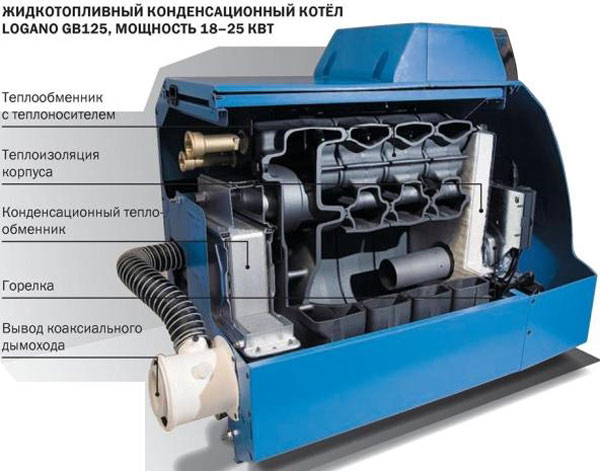
Boiler for heating a house with a solarium
There is another type of liquid fuel - waste oil. If there is an opportunity to take this energy resource somewhere, then you can build an economical stove for mining.
Super economical waste oil oven
Types of solid fuels for home heating: types and installation of boilers
Solid fuel, as a traditional type of energy resource for heating a private house, has always attracted special attention from manufacturers of heating equipment. Today you can choose a solid fuel boiler for every need and wallet. Let's take a closer look. All boilers are made of steel or cast iron.
- Steel heating boiler
This device has its advantages:
- Long burning time of one load 4-8 hours.
- Fast heating.
- Low cost of equipment.
- Aesthetic appearance.
But there are also disadvantages:
- The service life is 3-5 years.
- The likelihood of rust.
- Impossibility of repair due to solidity.

Solid fuels
- Cast iron boiler
The advantages of this boiler are obvious: high strength, and, accordingly, a long service life - up to 25 years; collapsible view, which facilitates transportation and allows equipment repair. Cast iron boilers are very unpretentious in terms of water quality. Of the minuses, a higher cost and sensitivity to temperature extremes can be noted. Cooling and condensation can be disastrous for this appliance.
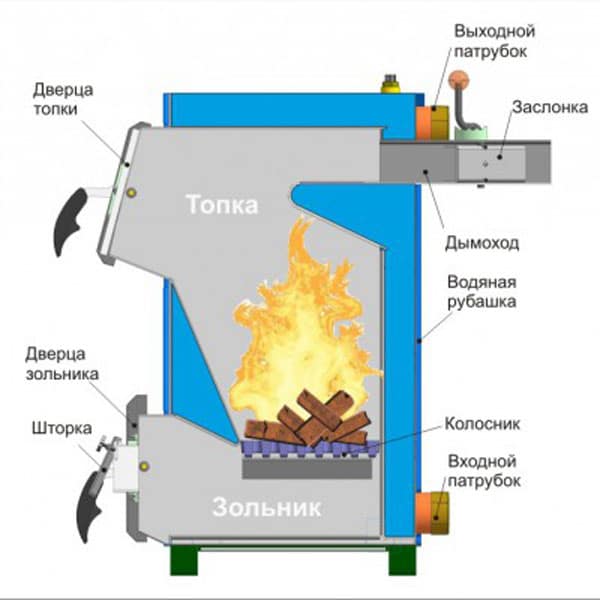
A simple diagram of the boiler device
Today, boilers are made for several types of fuel, mainly of woody nature: firewood, brown coal, anthracite, pellets (high quality compressed wood). The most convenient boilers are coal ones, where you can load any type of fuel, since the combustion temperature of coal is higher than that of firewood, so loading firewood into a coal boiler is quite acceptable.
Attention! The main rule for a long and safe operation of the boiler is dry fuel and compliance with the rules for its loading!

Pyrolysis boiler operation scheme
Another effective type of furnace is pyrolysis or gas generating boilers. They work on the basis of the decomposition of solid fuels and the formation of gas. These are boilers with the most efficient heat transfer, but rather high in cost.
The choice is yours, and you can connect the device yourself. To do this, just read the instruction manual or watch our video.
Connecting a solid fuel boiler for home heating
Water heating: diagrams and video instructions
Water heating circuits
Whichever type of fuel is chosen, the installation of a hot water heating system is done according to standard principles. The boiler works as a heat exchanger, transferring the temperature to the coolant - water. This is the basic principle of water heating at home. But what scheme to choose - each owner decides on his own. The water circulation system is natural and forced. With natural circulation, water under the influence of heating loses its density and rises along the vertical riser, getting into the heating system. Having passed its way through radiators and pipes, the water cools down and returns to the boiler. In this scheme, the main thing is the correct slopes of the pipes. If the tilt angles are not observed, the system will not function.

Scheme of natural circulation of the coolant
The second water circulation scheme is forced, it works with the help of a circulation pump. The connection diagram is simple.

Scheme of forced circulation of the coolant
In addition to the types of water circulation, water heating schemes are divided into single and double-circuit. A single-circuit system can operate according to both the first and the second principle of coolant circulation. The main thing in it is that the water, when heated in the boiler, goes all the way along one circuit and returns to the boiler. With a double-circuit or two-pipe system, water is supplied to the hot circuit, and comes out along the cold circuit or return line. The second type has received the greatest application due to the fact that only in this case, radiators on any section of the circuit can have the same temperature.
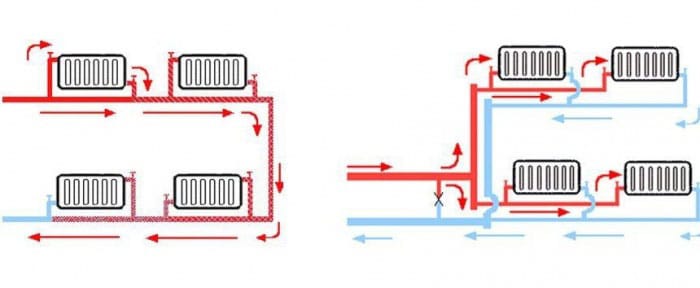
One- and two-pipe connection circuit
Basic principles of the system with a battery capacity
In the process of choosing a fuel, a boiler, a connection diagram and other subtleties of a private house heating scheme, the question arises of economy and safety. You can buy an expensive boiler and connect the most modern radiators, but on frosty winter days the fuel runs out catastrophically, and concern for the reliability of the entire heating system grows. To save energy and unload the boiler, an accumulator or buffer tank was invented in the water heating system. Its role is very well understood in the diagram below: the hot coolant enters the tank and gives off part of the excess heat to it, then continues on its way through the heating system, returning to the container in the form of cold water, which goes back to the boiler.
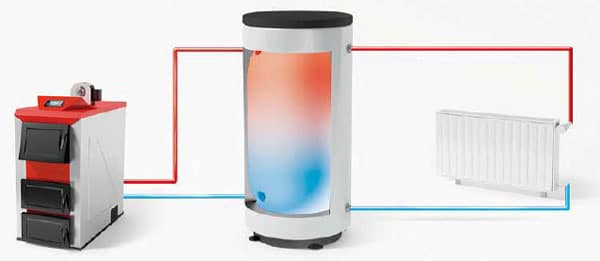
Heating system with buffer tank
With this connection, the stove will receive unloading, and you will save fuel, since when the boiler cools down, hot water from the storage tank continues to circulate around the circuit.
Heating with a buffer tank
DIY water floors
Water floors save energy well. Everything is explained by the heating temperature of the water circuit. If the battery heats up at least 75-90 degrees, then the water circuit is no more than 55 degrees. Light warm air rises and heats the room comfortably.
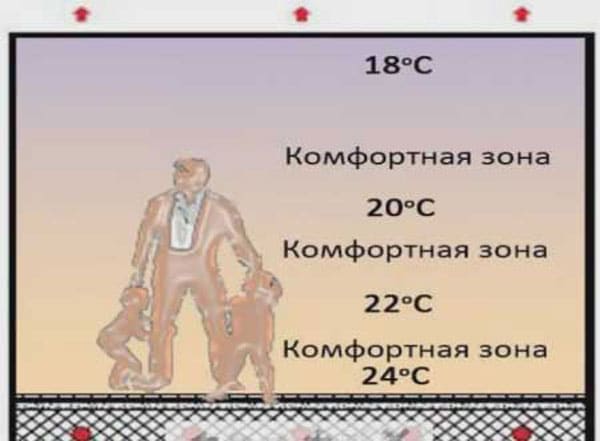
Comfortable room heating with a warm water floor
You can do such a heating system with your own hands, but you need to remember about several of its disadvantages:
- In severe frosts, additional heating sources will have to be installed, since on cold days a warm floor will not cope with heating the room.
- The thickness of the concrete screed should be at least 10 cm, and preferably from 20 to 30. If you want to put the floor in the finished house, you will have to either raise the doors or refuse this type of heating.
- The equipment is much more expensive than radiators and piping to them.

Hot water heating scheme with several underfloor heating circuits
There are a few more drawbacks, which are remembered only after installation. It is not advisable to put heavy furniture in the place where the water heating is installed, and not every floor covering can be put. From a medical point of view, a warm floor is not a very good idea, because from constant heating of the legs, such a formidable disease as varicose veins develops. But if you nevertheless decide to install, then the video material will help you do everything right.
A detailed master class on how to make a water floor with your own hands
Warm water walls
Warm walls are arranged in the same way as a warm water floor. This type of heating is very popular now in Western Europe, in particular in Germany. Heat loss with such heating is minimal, and heating is much cheaper than radiator heating. They are made in almost the same way, with the exception of the screed. The pipes are mounted on the wall, and then covered with drywall.
This room heating also has its drawbacks: poor air circulation, therefore, when installing warm walls, it is necessary to install supply and exhaust ventilation.
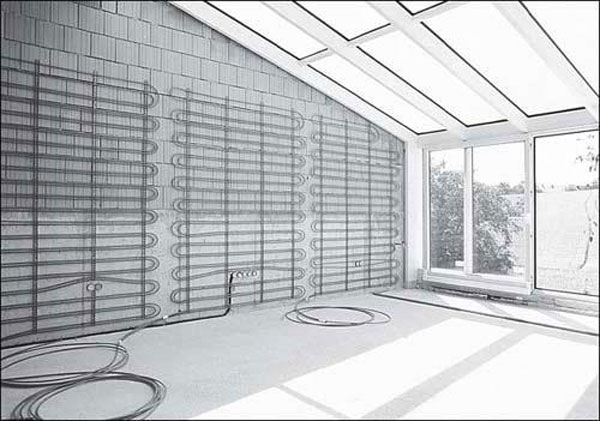
Water heating of walls
Skirting water heating system
This system functions in the same way as a conventional radiator-type heating circuit, with the difference that these are special radiators. They are attached along the entire perimeter of the room, and are covered with plastic panels from above.
There are many advantages in this design, and they are obvious, but one minus - such a radiator may not be enough on especially cold days for high-quality heating of a large room.
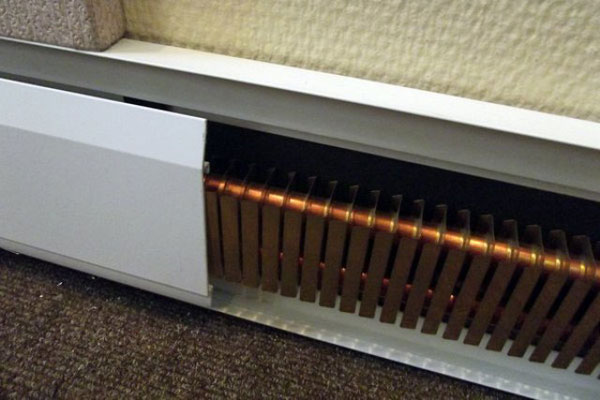
Skirting water radiator
How to choose a heating system
The choice of a heating system depends on several factors that must be carefully considered and weighed all the pros and cons.
- The first and foremost is the possibility of recoupment of such a system in the coldest months. Agree that it will be sad not to load the boiler due to lack of money for fuel, or to be unable to pay for electricity by installing electric heating circuits in the form of convectors or infrared heating. Make a detailed calculation of the heat and energy consumption per square meter of the house. This must be done before purchasing the equipment.
- An important factor when choosing a heating system will be its cost. In some sections, we have given the prices for equipment. Others you can look at on the website of companies selling this type of product. Add the installation work to this. You can do many things yourself using our recommendations and schemes, but some will have to be handed over to specialists.
- Before buying a solid fuel boiler, find out the exact calculation of its efficiency for the squares of your house. It is bad to buy a low-power boiler - you will freeze with it, but you do not need too powerful one either. In this case, you will have to spend excess fuel and open the vents even on a frosty day.
Attention! It is impossible to force a solid fuel boiler to reduce performance by more than 4-5 kW.
![]()
When an installer is needed
After all that has been said, let us summarize some of the results. You have learned a lot and, for sure, read additional literature, but you do not need to think that even with education, but without experience, you will be able to do absolutely all the steps correctly. A heating equipment installer will be needed in the following cases:
- When inserting into a main or gas-holder gas supply system. This is required by law and elementary safety - jokes are bad with gas. It is better to invite a specialist to the installation of a gas boiler.
- You can dilute a one-pipe water heating scheme based on diagrams and additional descriptions, but invite a specialist to install a two-pipe system. Together with him, you can learn and be confident in the quality of work.
- When constructing a water floor, a good concrete screed is required. If you doubt your abilities, invite a master. He will make it faster and more confident.
- Boiler installation is a very serious matter. One missing piece and you can't escape trouble. Expert advice will be very useful.
If you want to use our advice and the help of a master in especially difficult moments, a warm and comfortable home with adequate costs awaits you.



